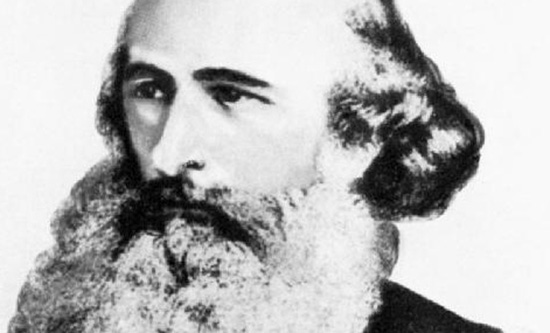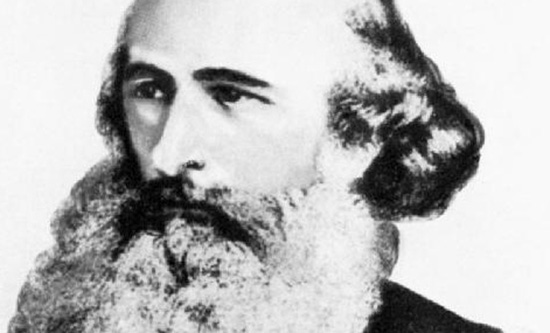
The US Civil War was fought between the northern states, who were loyal to the Union, and southern states that seceded from the Union to form the Confederate States of America. It resulted from the escalation of conflict over the right to extend slave-ownership.
Marx and Engels exchanged letters enthusiastically following events as they unfolded in North America from 1861 to 1866. In addition, between 1861 and 1862, Marx wrote regularly about the civil war for the radical New York Daily Tribune, which had a circulation of 200,000, and was also published in the Vienna Presse. His purpose was inform readers in Europe, the US and Britain about the progress of the war and to analyse the emerging class forces on both sides of the Atlantic in what he regarded as the most significant struggle of the day.
The immediate causes of the war
In Britain the bourgeois media, The Times, The Economist ‘and all the rest of the irrepressibly mean and grovelling press’, depicted the growing confrontation between the northern states and the slave-owning states of the South as an issue of interference in states’ rights by Federal dictates. Fortunately for his readers, and for us today, Marx summarised the matter with clarity:
‘As is known, the representation of the individual states in Congress depends, for the House of Representatives, on the number of persons constituting their respective populations. As the populations of the free states grow far more quickly than those of the slave states, the number of the Northern Representatives was bound very rapidly to overtake that of the Southern. The real seat of the political power of the South is accordingly transferred more and more to the American Senate, where every state, be it large or small, is represented by two senators. In order to maintain its influence in the Senate and through the Senate its hegemony over the United States, the South therefore required the continual formation of new slave states. This, however, was only possible through the conquest of foreign lands, as in the case of Texas, or through the transformation of the Territories belonging to the United States first into slave territories and later into slave states as in the case of Missouri, Arkansas etc.’
The new Republican Party was founded in 1854 to mobilise against the expansion of slave-owning rights by ‘sovereign’ states. Benefitting from splits in the old Democratic Party, Abraham Lincoln won the Presidential election in 1860 on the moderate platform of protecting the ‘peculiar institution’ of slavery where it existed, but preventing its extension. South Carolina immediately broke away from the Union and formed a new state – the Confederacy – with 11 other Southern slave states. In April 1861, the Civil War began when Confederate shore batteries opened fire on Fort Sumter, a Union garrison in Charleston Harbour.
The institution of slavery
Marx and Engels viewed slavery as intrinsic to the development of capitalism, not as a pre-capitalist mode of production. Marx wrote, ‘Needless-to-say, we are dealing with direct slavery which is just as much a pivot of bourgeoise industry as machinery, credits etc. Slavery is an economic category like any other, it is not a discrete event.’ Indeed, British and US banking were heavily invested in slave-dependent businesses. As late as 1850 New York state had the highest number of slaves of the 34 states of the Union and slaving ships were still being built there in the 1860s. At this time, however, rapid changes occurred in the material basis of the US economy. As Marx noted the ‘extraordinary development of the North Western states’ would be a decisive factor in the struggle against slave-owning. One million emigrants from the Irish famines and thousands of settlers from Europe entered the country as a new labour force. Railroad, shipping and banking interests rapidly moved out of the slave trade, which put limits on the developing internal market with the massive growth of wage labour. The profitability of slave plantation cash crops (cotton, sugar and tobacco) fell rapidly in comparison with the booming agriculture and industry in the North.
The British ruling class and the Civil War
The British ruling class was divided over which side to support. Some, like Viscount Wolseley, later commander of the British Army, backed the ‘aristocratic’ South: ‘the descendants of our banished cavaliers’. There were concerns that the US would try to get Canada, the St Lawrence River and Britain’s Caribbean possessions.
Prime Minister Lord Palmerston acted throughout in accordance with his own principle that Britain had ‘no permanent allies, only permanent interests’. In the end, however, as Marx noted, ‘the trade in wheat won over the importation of cotton’. Alternative sources for cotton were used; the area under cotton cultivation in Egypt increased fivefold between 1860 and 1865.
The British working class and the Civil War
In contrast, large sections of the British working class identified with the demand for emancipation, sending a letter from a mass meeting in London requesting the US President ‘to continue his work and thereby achieve the glorious principle on which your constitution is founded – the brotherhood, freedom and equality of all men’. Workers in the Lancashire cotton mills voted to support the blockade on cotton exports, despite this leading to mass unemployment and starvation. Lincoln acknowledged the self-sacrifice of the ‘working men of Manchester’ in words later inscribed on the pedestal of his statue that still stands in the city’s Lincoln Square, praising their ‘selfless act of sublime Christian heroism, which has not been surpassed in any age or in any country’. These words were followed by US relief ships packed with provisions sent by grateful Americans as an act of brotherhood between the Union states and Lancashire.
Revolutionary hopes
Marx and Engels reported on the Civil War to the International Workingmen’s Association – the First International – which was founded in September 1864 with five to eight million members and aimed to unite a variety of left-wing socialist, communist and anarchist groups and trade unions based on class struggle. In a letter to President Lincoln in February 1865, the Association’s Central Council congratulated the American people on his re-election by a large majority. In reply Lincoln stated that his government had derived ‘new encouragement to persevere from the testimony of the workingmen of Europe that the national attitude is favoured with their enlightened approval and earnest sympathies’. He was assassinated two months later.
For Marx and Engels, the Civil War was a struggle between revolution and counter-revolution. They saw in the emergence of a working class in the US the potential for challenges to the power of capital. They had hopes that when the political dominance of the slave owners was defeated, the power of industrial and financial capital might next be contested.
Within the forces of the Union Army there were many communists. One quarter of the army was born overseas and one tenth were German. Many of these were ‘men of 1848’, the revolutionaries of the rebellion against European regimes and monarchies who had fled to the US. They included communist generals like August Willich and Franz Sigel. Together with military commander John C Fremont, who was the first nominee for the Republican Party, they fought for full integration of the armed forces and for arming the slave freedom fighters.
Marx and Engels had every reason to believe that the US would move on to a new revolutionary phase as the Civil War drew to a close. They initially had hopes in President Johnson, Lincoln’s successor. ‘He is’, Marx wrote on 1 May 1865, ‘stern, inflexible, revengeful and as a former poor white has a deadly hatred of the oligarchy’. Still hopeful, Engels replied, ‘In any case, Johnson will insist on the confiscation of the large landed property and thereby make the pacification and reorganisation of the South a somewhat more acute matter’. By June 1866 Marx says, ‘Johnson’s policy disquiets me…the reaction has already begun in America and will soon be greatly strengthened’. Engels predicted, ‘If things carry on like this in six months’ time all the old villains of secession will be sitting in Congress in Washington.’ He was correct. The defeated forces of the South launched an orgy of reaction – racist violence and economic oppression that forced the emigration of millions of African Americans from the southern states.
Reconstruction and share-cropping
After the war, a Joint Committee on Reconstruction formulated the Fourteenth Amendment to the Constitution, enshrining the principle of ‘birthright citizenship’ and requiring all states to observe ‘the principles of due process and equal protection of the law for all’. Within weeks organisations registering African American voters were attacked, with 1,300 murders and burnings before the 1868 election. From 1868 to 1876 there were between 50 and 100 lynchings a year – some staged as the central event of huge public gatherings followed by postcards and cartoons for sale. Membership of the racist Klu Klux Klan, formed in 1866 by factions within the slave-owner supporting Democratic Party, grew from all sectors of the white population and functioned to spread generalised terror. Targeted killings were carried out against the leadership of the African American community.
The economic reconstruction of the South enforced trapped and dependent ‘free’ labour. Confiscated land was distributed in small parcels for the production of subsistence and cash crops, but there was no money for seed, tools or labour. The political power of local banks, small town bosses and store owners dominated social life supported in some, but by no means all, of the two-thirds of the share-croppers who were poor white immigrants. These combined forces of reaction imposed local ‘Jim Crow’ laws to disenfranchise and segregate African Americans throughout the South. Fearful at the prospect of a potentially revolutionary alliance between some of the poorest sections of the white working class and the emancipated black population that had begun to emerge during Reconstruction, the industrial ruling class in the North gave tacit approval for the old plantocracy to regain control and enforce segregation.
Resistance
African Americans continued the fight for civil rights, creating their own churches, schools and universities. At times black and white workers united, creating out of their shared experience of class oppression organisations like the Alabama Sharecroppers Union (1931 to 1936) and the Communist Party-led Trade Union Unity League established in 1930. Meanwhile, white terror continued. Between 1877 and 1950 more than 4,000 African Americans were lynched. A hundred years after the first of 200 proposals to make lynching a Federal hate crime was put to the US House of Representatives, a bill was finally voted through in February 2020. By June, the legislation was still being delayed for fear that police murder, like that of George Floyd, would be classed as ‘lynching’.
Legacy of the Confederacy
Added to the nearly 1,800 Confederate monuments and statues in the US many locations, parks, military bases, highways and government buildings are named after Confederate leaders. Significantly, many were established between the 1890s and 1950s as a visual reminder of southern Democrats’ continued rejection of the constitutional rights won from the Civil War. In contrast to the earlier memorials mourning over one million dead combatants, these monuments glorify the leaders of the Confederacy who fought for slavery.
Addressing supporters on an Independence Day event in front of the Mount Rushmore memorial, President Trump condemned ‘Angry mobs trying to tear down statues of our founders, deface our most sacred memorials, unleash a wave of violent crime in our cities… This left-wing cultural revolution is designed to overthrow the American Revolution.’ Trump sides with the legacy of the Confederacy and seeks to maintain white supremacy. We stand in the tradition of Marx and Engels and of building a movement for liberation; a movement that must arise from the depths of race and class oppression. We take inspiration from the fightback of African Americans and their supporters in the US today.
Susan Davidson
FIGHT RACISM! FIGHT IMPERIALISM! 277 August/September 2020




